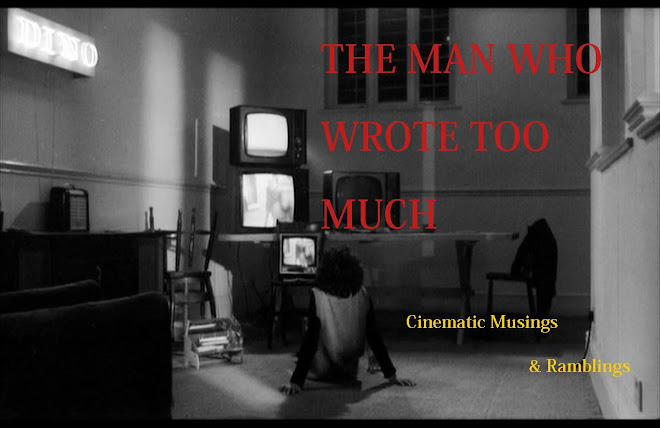Now freed from these fetters of studio imposition, and armed solely with a Sony PD150 (I’m no expert but understand this is only one notch above a standard commercial digital video camera), this is Lynch the painter and sculptor set free. INLAND EMPIRE presents us with Mr. David Lynch uncensored, unabashed and unbridled, the purest ‘Lynchian’ universe yet, mainlined uncut straight into our retinas. An experience that is by turns confusing, surreal, maddening, frightening, disturbing and hilarious.
+1.JPG)
Trying to define the film in terms of a brief synopsis is an unenviable task, but essentially the film concerns one Nikki Grace (Laura Dern), a Hollywood actress who receives her dream role in a film titled On High in Blue Tomorrows. This turns out to be a remake of a Polish production never finished due to the mysterious deaths of its two main stars. For the first 45 minutes or so this makes up the plot that we manage to loosely grasp on to. Beyond this point though we appear to enter the subjective world of Nikki’s apparent mental breakdown, as the film breaks off into strands way too numerous and sinuous to mention here as we delve deeper and deeper into planet Lynch for the next two hours (the finished product falling some eight minutes short of three hours).
Whether intentional or not, Lynch has created a provocative piece of work with INLAND EMPIRE. When cinema usually attempts to break free from the burdens of its status as the bastard child of literature, we find it confined to the margins of art installations. Lynch’s film attempts to defy such rules, the world he has created here does not have any obvious precedents in literature (an argument could be made for the great provocateur Joyce, but let’s not bother). This swirling sense of dream logic leaves the viewer with questions as to the nature of cinematic purity. Is INLAND EMPIRE in its staunch refusal of traditional storytelling devices, a final realisation of the language of cinema?
This unwillingness to compromise his vision unfortunately leaves the viewer having to do so at the cost of their own enjoyment. For example, our struggle to comprehend the events unfolding leaves us unable to fully appreciate the nuances of Laura Dern’s finest moment so far. In an unforgiving performance, Dern is forced to embody many difference characterisations and does so brilliantly. A bewildered film starlet, downtrodden housewife and destitute streetwalker, Dern embodies all the characters convincingly and with an empathy that lends a definite emotional resonance to a film that could otherwise appear too incorporeal to accommodate any sense of gravitas.
+2.JPG)
The new future world of digital Lynch also leads to a series of compromises. The freedom such small scale shooting has granted him comes at the cost of the lush cinematography we usually associate with Lynch. The PD150 gives the film the occasional look of a film student dissertation project, yet Lynch somehow largely works this to his advantage. The camera seems to spend 90% of its time in unflatteringly obtrusive medium close-ups with lighting rigged up with all the subtlety of fluorescent tubing in a late night takeaway. Lending the film a cold, paranoid, voyeuristic and increasingly claustrophobic look, it’s perfectly 21st century.
Continuing this theme, rather than the noirish Los Angeles pictured in Mulholland Drive (2001), here Lynch gives his adopted home town short shrift, there appears to be no middle ground between the opulent plasticity of the Beverly Hills highlife and the ragged boulevards of broken dreams around Hollywood and Vine. This makes for another fine addition to the ‘city of angels’ many unflattering portraits.
+3.JPG)
One area which undeniably remains strong is the soundtrack, despite the lack of compositions from regular collaborator Angelo Badalamenti, the music still carries the evocative ambiance we associate with Lynch, here appearing in the form of Eno like ambient passages and haunting chanteuse numbers (ala Julee Cruise). Lynch’s tendency to subvert pop standards remains solidly in place as well, this time “The Locomotion” being the track forevermore tainted with a certain seediness.
And so to finally return to my initial point, if Lynch as a director divides cinemagoers, then INLAND EMPIRE is the film that divides Lynch fans, while some will decree its unsettling fevered breakdown nightmare as his finest and truest work to date, an equal amount will no doubt see it as an overlong step too far into surrealism at the cost of structured enjoyment.
Personally I found the best method is to adjust to the film’s inner rhythm, start to get bored regardless, then find yourself drawn back in by a moment of pure audaciousness, repeating every few minutes for three hours.

Greetings,
ReplyDeleteLooking for the origin of the mysterious rabbits or the meaning behind the axxonn equation? Check out this new eBook that reveals David Lynch's INLAND EMPIRE. Old World Politics, New World Prophecy: Understanding David Lynch's INLAND EMPIRE available now at Amazon.com, Amazon.co.uk and Amazon.co.de. Here is the link:
http://www.amazon.com/World-Politics-Prophecy-Understanding-ebook/dp/B004LGS7I6/ref=sr_1_2?ie=UTF8&qid=1309667177&sr=8-2